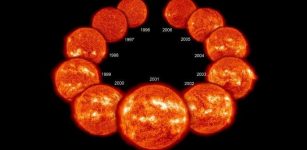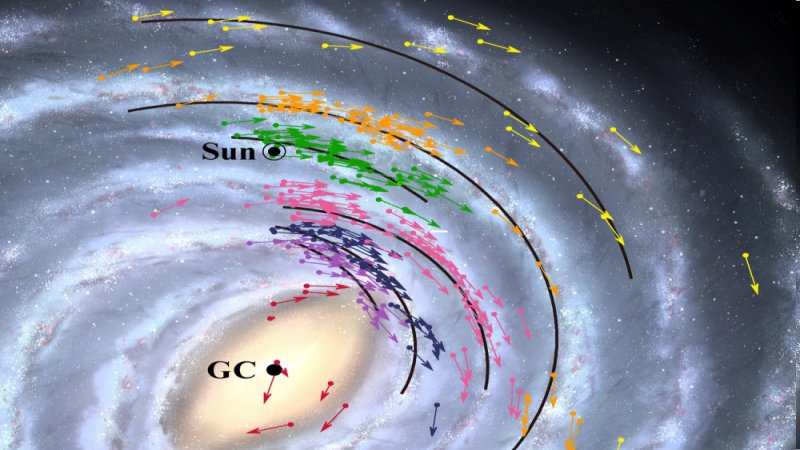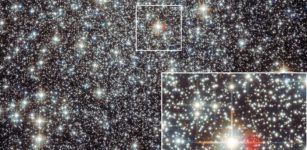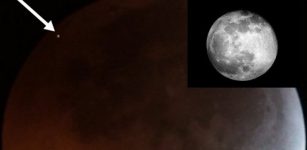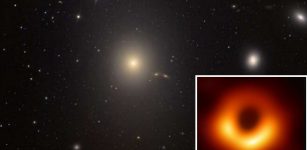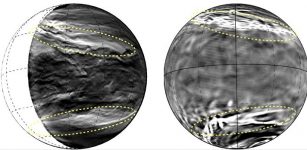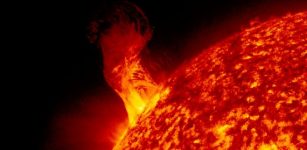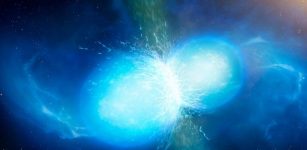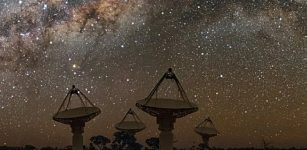Scientists Explain Why Uranus And Neptune Are Different Colors
Eddie Gonzales Jr. – MessageToEagle.com – Observations from Hubble Space Telescope, the NASA Infrared Telescope and the Gemini Observatory, reveal that excess haze on Uranus makes it paler than Neptune and that dark spots are caused by a darkening of a second deeper cloud/haze layer.
Uranus and Neptune. NASA’s Voyager 2 spacecraft captured these views of Uranus (on the left) and Neptune (on the right) during its flybys of the planets in the 1980s. Credit: NASA/JPL-Caltech/B. Jónsson
Astronomers may now understand why the similar planets Uranus and Neptune are different colors. Using observations from the Hubble Space Telescope, the NASA Infrared Telescope Facility, and the Gemini North telescope, researchers have developed a single atmospheric model that matches observations of both planets. The model reveals that excess haze on Uranus builds up in the planet’s stagnant, sluggish atmosphere and makes it appear a lighter tone than Neptune. The model also reveals the presence of a second, deeper layer that, when darkened, can account for dark spots in these atmospheres, such as the famous Great Dark Spot (GDS) observed by Voyager 2 in 1989.
Neptune and Uranus have much in common—they have similar masses, sizes, and atmospheric compositions—yet their appearances are notably different. At visible wavelengths Neptune has a distinctly bluer color than Uranus and astronomers now have an explanation for why this might be.
New research suggests that a layer of concentrated haze that exists on both planets is thicker on Uranus than a similar layer on Neptune and “whitens” Uranus’s appearance more than Neptune’s. If there were no haze in the atmospheres of Neptune and Uranus, both would appear almost equally blue.
This conclusion comes from a model that an international team led by Patrick Irwin, Professor of Planetary Physics at Oxford University, developed to describe aerosol layers in the atmospheres of Neptune and Uranus. Previous investigations of these planets’ upper atmospheres had focused on the appearance of the atmosphere at only specific wavelengths. However, this new model, consisting of multiple atmospheric layers, matches observations from both planets across a wide range of wavelengths simultaneously. The new model also includes haze particles at deeper layers that had previously been thought to contain only clouds of methane and hydrogen sulfide ices.
“This is the first model to simultaneously fit observations of reflected sunlight from ultraviolet to near-infrared wavelengths,” explains Professor Irwin, who is the lead author of a paper presenting this result in the Journal of Geophysical Research: Planets. “It’s also the first to explain the difference in visible color between Uranus and Neptune.”
The team’s model consists of three layers of aerosols at different heights. The key layer that affects the colors is the middle layer, which is a layer of haze particles (referred to in the paper as the Aerosol-2 layer) that is thicker on Uranus than on Neptune. The team suspects that, on both planets, methane ice condenses onto the particles in this layer, pulling the particles deeper into the atmosphere in a shower of methane snow. Because Neptune has a more active, turbulent atmosphere than Uranus does, the team believes Neptune’s atmosphere is more efficient at churning up methane particles into the haze layer and producing this snow. This removes more of the haze and keeps Neptune’s haze layer thinner than it is on Uranus, making Neptune bluer than Uranus.
“We hoped that developing this model would help us understand clouds and hazes in the ice giant atmospheres,” comments Mike Wong, an astronomer at the University of California, Berkeley, and a member of the team behind this result. “Explaining the difference in color between Uranus and Neptune was an unexpected bonus!”
To create this model, Professor Irwin’s team analyzed a set of observations of the planets encompassing ultraviolet, visible, and near-infrared wavelengths (from 0.3 to 2.5 micrometers) taken with the NASA/ESA Hubble Space Telescope, the NASA Infrared Telescope Facility located near the summit of Maunakea in Hawai’i, and the Gemini North Telescope, also located in Hawai’i.
The model also helps explain the dark spots that are occasionally visible on Neptune and more sporadically on Uranus. While astronomers were already aware of the presence of dark spots in the atmospheres of both planets, they didn’t know which aerosol layer was causing these dark spots or why the aerosols at those layers were less reflective. The team’s research sheds light on these questions by showing that a darkening of the particles in the deepest layer of their model would produce dark spots very similar to those seen on Neptune and occasionally on Uranus.
Written by Eddie Gonzales Jr. – MessageToEagle.com Staff


